Turbulent Characteristics of a Submerged Reef under Various Current and Submergence Conditions
Abstract
:1. Introduction
2. Materials and Methods
2.1. Experiment Setup
2.2. Numerical Model Setup
2.3. Model Validation
3. Results
3.1. Flow Field
3.1.1. Vertical and Transversal Flow Fields under a Constant Inflow and Submergence
3.1.2. Flow Fields under Different Inflows and Submergences
3.2. Vorticity Pattern
3.2.1. Vertical and Transversal Vorticity Patterns under a Constant Inflow and Submergence
3.2.2. Vorticity Patterns under Different Constant Inflows and Submergences
3.3. Turbulent Intensity
3.3.1. Vertical and Transversal Turbulent Intensity Distribution under a Constant Inflow and Submergence
3.3.2. Turbulent Intensity Distribution under Different Constant Inflows and Submergences
4. Discussion
4.1. The Impact of Inflow and Submergence on the Length of the Back Wake
4.2. The Impact of Inflow and Submergence on the High-Vorticity Dipoles
5. Conclusions
- (a)
- As the main flow passes through the SR, the upwelling is produced in front of the SR and a large-scale wake region is formed behind the SR, which contains a clockwise vortex. The vortex structure formed inside the SR is induced by the interaction between wake currents from the lee side and the jet-like flow from the stoss face openings.
- (b)
- In terms of the same submergence, as the inflow velocity increases, the relative back wake length increases gradually, as well as the area and mean values of the high-vorticity region inside the SR. The turbulent intensity distributed inside and behind the SR is enhanced with a higher inflow velocity.
- (c)
- In terms of the same inflow velocity, as the submergence increases, the relative back wake length increases, while the high-vorticity region above the SR crest expands along the vertical direction and constricts along the longitudinal direction. The area of high-vorticity dipoles within the SR decreases as submergence increases, while the mean vorticity value decreases at an inflow velocity of 0.09 m/s and increases at a higher inflow velocity. Moreover, the turbulent intensity in the vicinity of the SR gradually attenuates.
Author Contributions
Funding
Institutional Review Board Statement
Informed Consent Statement
Data Availability Statement
Conflicts of Interest
References
- Jiang, Z.; Liang, Z.; Tang, Y.; Huang, L.; Yu, D.; Jiang, M. Numerical Simulation and Experimental Study of the Hydrodynamics of a Modeled Reef Located within a Current. Chin. J. Oceanol. Limnol. 2010, 28, 267–273. [Google Scholar] [CrossRef]
- Kallianiotis, A.A.; Batjakas, I.E. Temporal and Environmental Dynamics of Fish Stocks in the Marine Protected Area of the Artificial Reef of Kitros, Pieria (Northern Greece, Mediterranean Sea). J. Mar. Sci. Eng. 2023, 11, 1773. [Google Scholar] [CrossRef]
- Oteiza, P.; Odstrcil, I.; Lauder, G.; Portugues, R.; Engert, F. A Novel Mechanism for Mechanosensory-Based Rheotaxis in Larval Zebrafish. Nature 2017, 547, 445–448. [Google Scholar] [CrossRef]
- Ng, K.; Phillips, M.R.; Calado, H.; Borges, P.; Veloso-Gomes, F. Seeking Harmony in Coastal Development for Small Islands: Exploring Multifunctional Artificial Reefs for São Miguel Island, the Azores. Appl. Geogr. 2013, 44, 99–111. [Google Scholar] [CrossRef]
- Relini, G.; Relini, M.; Palandri, G.; Merello, S.; Beccornia, E. History, Ecology and Trends for Artificial Reefs of the Ligurian Sea, Italy. Hydrobiologia 2007, 580, 193–217. [Google Scholar] [CrossRef]
- Bohnsack, J.A.; Johnson, D.L.; Ambrose, R.F. 3—Ecology of Artificial Reef Habitats and Fishes. In Artificial Habitats for Marine and Freshwater Fisheries; Seaman, W., Sprague, L.M., Eds.; Academic Press: San Diego, CA, USA, 1991; pp. 61–107. ISBN 978-0-08-057117-1. [Google Scholar]
- Hirose, N.; Watanuki, A.; Saito, M. New Type Units for Artificial Reef Development of Eco-Friendly Artificial Reefs and the Effectiveness Thereof. In 30th PIANC-AIPCN Congress 2002; Institution of Engineers: Sydney, Australia, 2002. [Google Scholar]
- Armono, H. Wave Transmission on Submerged Breakwaters Made of Hollow Hemispherical Shape Artificial Reefs. In Proceedings of the Canadian Coastal Conference, Kingston, ON, Canada, 15–17 October 2003; Volume 2003. [Google Scholar]
- Buccino, M.; Del Vita, I.; Calabrese, M. Predicting Wave Transmission Past Reef BallTM Submerged Breakwaters. J. Coast. Res. 2013, 65, 171–176. [Google Scholar] [CrossRef]
- Srisuwan, C.; Rattanamanee, P. Modeling of Seadome as Artificial Reefs for Coastal Wave Attenuation. Ocean Eng. 2015, 103, 198–210. [Google Scholar] [CrossRef]
- Van Gent, M.R.A.; Buis, L.; Van Den Bos, J.P.; Wüthrich, D. Wave Transmission at Submerged Coastal Structures and Artificial Reefs. Coast. Eng. 2023, 184, 104344. [Google Scholar] [CrossRef]
- Metallinos, A.S.; Repousis, E.G.; Memos, C.D. Wave Propagation over a Submerged Porous Breakwater with Steep Slopes. Ocean Eng. 2016, 111, 424–438. [Google Scholar] [CrossRef]
- Panizzo, A.; Briganti, R. Analysis of Wave Transmission behind Low-Crested Breakwaters Using Neural Networks. Coast. Eng. 2007, 54, 643–656. [Google Scholar] [CrossRef]
- Tsai, C.-C.; Chang, Y.-H.; Hsu, T.-W. Step Approximation on Oblique Water Wave Scattering and Breaking by Variable Porous Breakwaters over Uneven Bottoms. Ocean Eng. 2022, 253, 111325. [Google Scholar] [CrossRef]
- Zheng, S.; Meylan, M.; Zhang, X.; Iglesias, G.; Greaves, D. Performance of a Plate-wave Energy Converter Integrated in a Floating Breakwater. IET Renew. Power Gener. 2021, 15, 3206–3219. [Google Scholar] [CrossRef]
- Khan, M.B.M.; Gayathri, R.; Behera, H. Wave Attenuation Properties of Rubble Mound Breakwater in Tandem with a Floating Dock against Oblique Regular Waves. Waves Random Complex Media 2021, 1–19. [Google Scholar] [CrossRef]
- Naik, N.; Behera, H. Role of Dual Breakwaters and Trenches on Efficiency of an Oscillating Water Column. Phys. Fluids 2023, 35, 047115. [Google Scholar] [CrossRef]
- Fang, L.; Chen, P.; Chen, G.; Tang, Y.; Yuan, H.; Feng, X. Preliminary Evaluation on Resources Enhancement of Artificial Reef in the East Corner of Zhelang Shanwei. Asian Agric. Res. 2013, 5, 111–115. [Google Scholar] [CrossRef]
- Liu, T.-L.; Su, D.-T. Numerical Analysis of the Influence of Reef Arrangements on Artificial Reef Flow Fields. Ocean Eng. 2013, 74, 81–89. [Google Scholar] [CrossRef]
- Jang, S.-C.; Jeong, J.-Y.; Lee, S.-W.; Kim, D. Identifying Hydraulic Characteristics Related to Fishery Activities Using Numerical Analysis and an Automatic Identification System of a Fishing Vessel. J. Mar. Sci. Eng. 2022, 10, 1619. [Google Scholar] [CrossRef]
- Lin, J.; Zhang, S. Research Advances on Physical Stability and Ecological Effects of Artificial Reef. Marine Fish./Haiyang Yuye 2006, 28, 257–262. [Google Scholar]
- Tang, Y.L.; Long, X.Y.; Wang, X.X.; Jiang, Z.Y.; Cheng, H.; Zhang, T.Z. Comparative analysis on flow field effect of general artifi-cial reefs in China. Trans. Chin. Soc. Agric. Eng. 2017, 33, 97–103. [Google Scholar] [CrossRef]
- Jiang, Z.Y. Artificial Reef Hydrodynamics and Numerical Simulation Study. Ph.D. Thesis, Ocean University of China, Qingdao, China, 2009. [Google Scholar]
- Maslov, D.; Pereira, E.; Duarte, D.; Miranda, T.; Ferreira, V.; Tieppo, M.; Cruz, F.; Johnson, J. Numerical Analysis of the Flow Field and Cross Section Design Implications in a Multifunctional Artificial Reef. Ocean Eng. 2023, 272, 113817. [Google Scholar] [CrossRef]
- Kim, D.; Woo, J.; Yoon, H.S.; Na, W.B. Efficiency, tranquillity and stability indices to evaluate performance in the artificial reef wake region. China Ocean Eng. 2016, 122, 253–261. [Google Scholar] [CrossRef]
- Paxton, A.B.; Peterson, C.H.; Taylor, J.C.; Adler, A.M.; Pickering, E.A.; Silliman, B.R. Artificial reefs facilitate tropical fish at their range edge. Commun. Biol. 2019, 2, 168. [Google Scholar] [CrossRef]
- Fabi, G.; Grati, F. Adriatic Sea: The role of artificial reefs in the marine spatial planning. In Proceedings of the RECIF Conference on Artificial Reefs: From Materials to Ecosystem, Caen, France, 27–29 January 2015. [Google Scholar]
- Gates, A.R.; Horton, T.; Serpell-Stevens, A.; Chandler, C.; Grange, L.J.; Robert, K.; Bevan, A.; Jones, D.O.B. Ecological role of an offshore industry artificial structure. Front. Mar. Sci. 2019, 6, 675. [Google Scholar] [CrossRef]
- Spring, D.L.; Williams, G.J. Influence of Upwelling on Coral Reef Benthic Communities: A Systematic Review and Meta-Analysis. Proc. R. Soc. B Biol. Sci. 2023, 290, 20230023. [Google Scholar] [CrossRef]
- Stocking, J.; Rippe, J.; Reidenbach, M. Structure and Dynamics of Turbulent Boundary Layer Flow over Healthy and Algae-Covered Corals. Coral Reefs 2016, 35, 1047–1059. [Google Scholar] [CrossRef]
- Stocking, J.; Laforsch, C.; Sigl, R.; Reidenbach, M. The Role of Turbulent Hydrodynamics and Surface Morphology on Heat and Mass Transfer in Corals. J. R. Soc. Interface 2018, 15, 20180448. [Google Scholar] [CrossRef] [PubMed]
- Reidenbach, M.A.; Stocking, J.B.; Szczyrba, L.; Wendelken, C. Hydrodynamic Interactions with Coral Topography and Its Impact on Larval Settlement. Coral Reefs 2021, 40, 505–519. [Google Scholar] [CrossRef]
- Zheng, Y.; Kuang, C.; Zhang, J.; Gu, J.; Chen, K.; Liu, X. Current and turbulent characteristics of perforated box-type artificial reefs in a constant water depth. Ocean Eng. 2022, 244, 110359. [Google Scholar] [CrossRef]
- Silva, A.T.; Katopodis, C.; Santos, J.M.; Ferreira, M.T.; Pinheiro, A.N. Cyprinid Swimming Behaviour in Response to Turbulent Flow. Ecol. Eng. 2012, 44, 314–328. [Google Scholar] [CrossRef]
- Silva, A.T.; Santos, J.M.; Ferreira, M.T.; Pinheiro, A.N.; Katopodis, C. Effects of Water Velocity and Turbulence on the Behaviour of Iberian Barbel (Luciobarbus Bocagei, Steindachner 1864) in an Experimental Pool-Type Fishway. River Res. Appl. 2011, 27, 360–373. [Google Scholar] [CrossRef]
- Goettel, M.T.; Atkinson, J.F.; Bennett, S.J. Behavior of Western Blacknose Dace in a Turbulence Modified Flow Field. Ecol. Eng. 2015, 74, 230–240. [Google Scholar] [CrossRef]
- Fischer, J.L.; Filip, G.P.; Alford, L.K.; Roseman, E.F.; Vaccaro, L. Supporting Aquatic Habitat Remediation in the Detroit River through Numerical Simulation. Geomorphology 2020, 353, 107001. [Google Scholar] [CrossRef]
- Hashempour, M.; Kolahdoozan, M. Three-Dimensional Modeling of Dilute Sediment Concentration around the Synthetic Sponge Inspired by the Tubular Sponge Mechanism. Ocean Eng. 2023, 271, 113799. [Google Scholar] [CrossRef]
- Hashempour, M.; Kolahdoozan, M. Inspiration of Marine Sponges to Design a Structure for Managing the Coastal Hydrodynamics and Protection: Numerical Study. Front. Mar. Sci. 2023, 10, 1091540. [Google Scholar] [CrossRef]
- Van Heijst, G.J.F.; Flor, J.B. Dipole formation and collisions in a stratified fluid. Nature 1989, 340, 212–215. [Google Scholar] [CrossRef]
- Pope, S.B. Turbulent Flows; Cambridge University Press: Cambridge, UK, 2000. [Google Scholar]
- Nst, O.A.; Brve, E. Flow separation, dipole formation and water exchange through tidal strait. Ocean. Sci. 2021, 17, 1403–1420. [Google Scholar] [CrossRef]
- Afanasyev, Y. Formation of vortex dipoles. Phys. Fluids 2006, 18, 159. [Google Scholar] [CrossRef]
- ANSYS. Ansys-Fluent, Release 17.0; ANSYS Inc.: Canonsburg, PA, USA, 2017. [Google Scholar]
- Li, X.; Luan, S.; Chen, Y.; Zhang, R. The 3D vortex structure of cube artificial reef’s wake vortex. J. Dalian Ocean. Univ. 2012, 27, 572–577. [Google Scholar] [CrossRef]
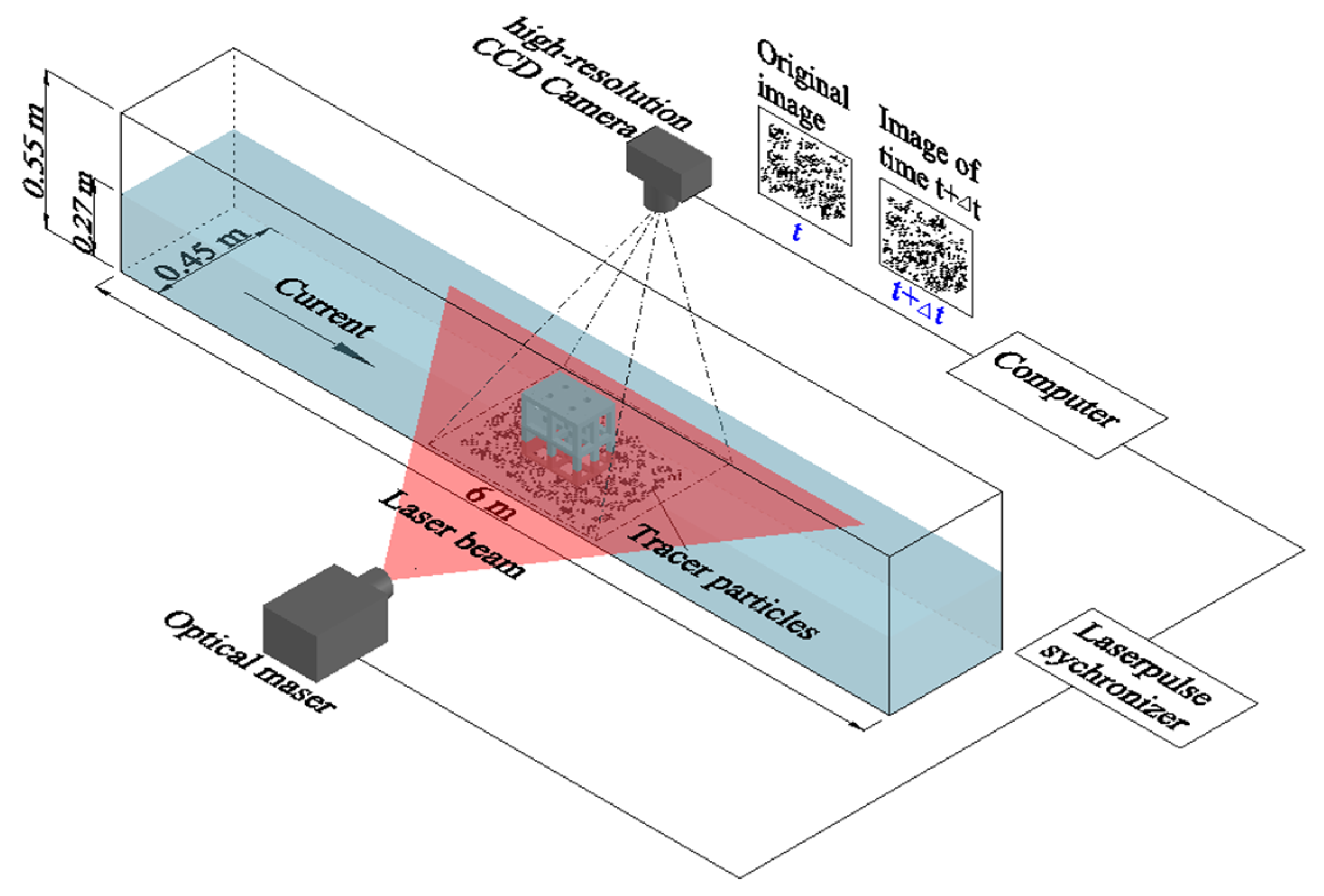
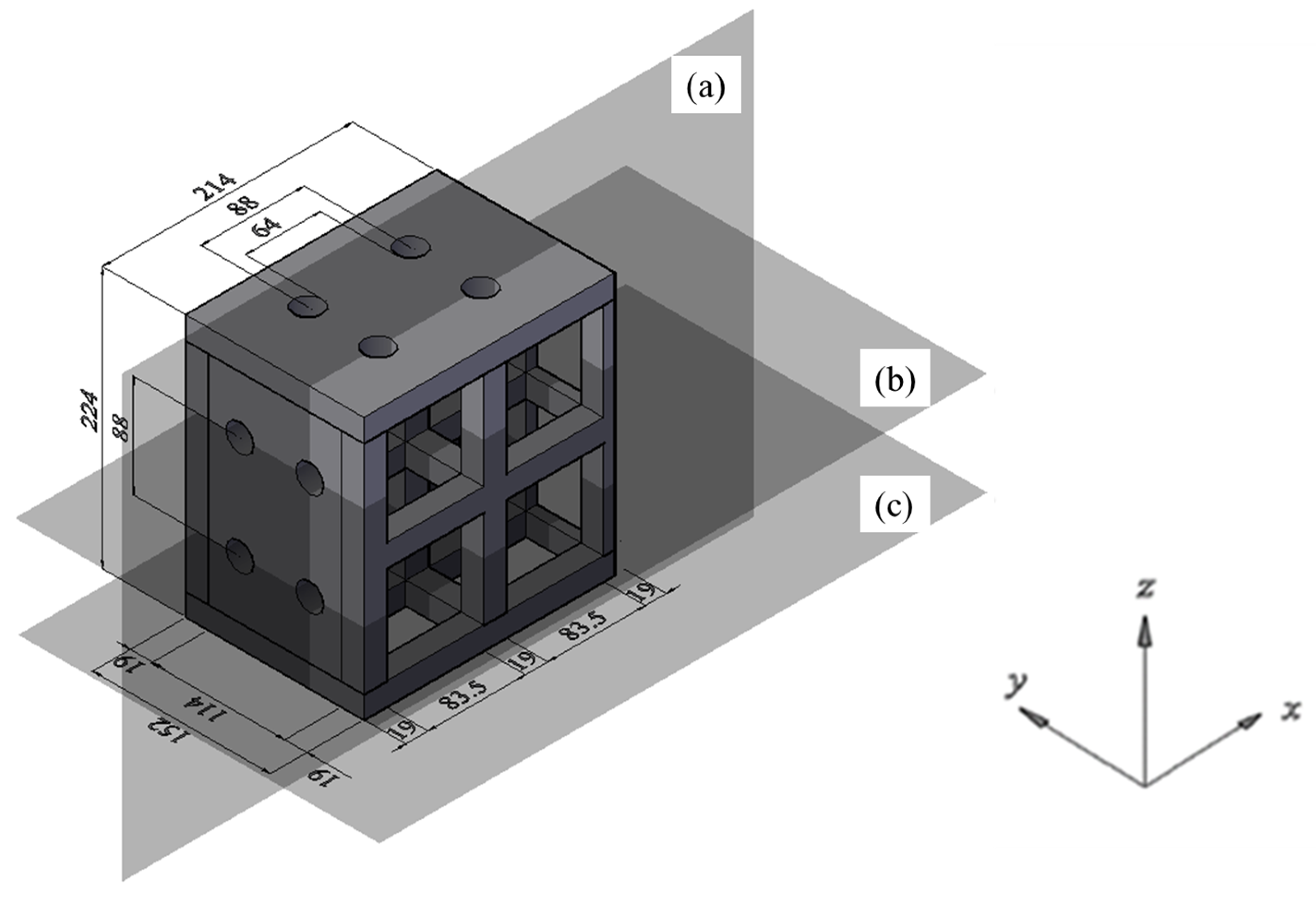

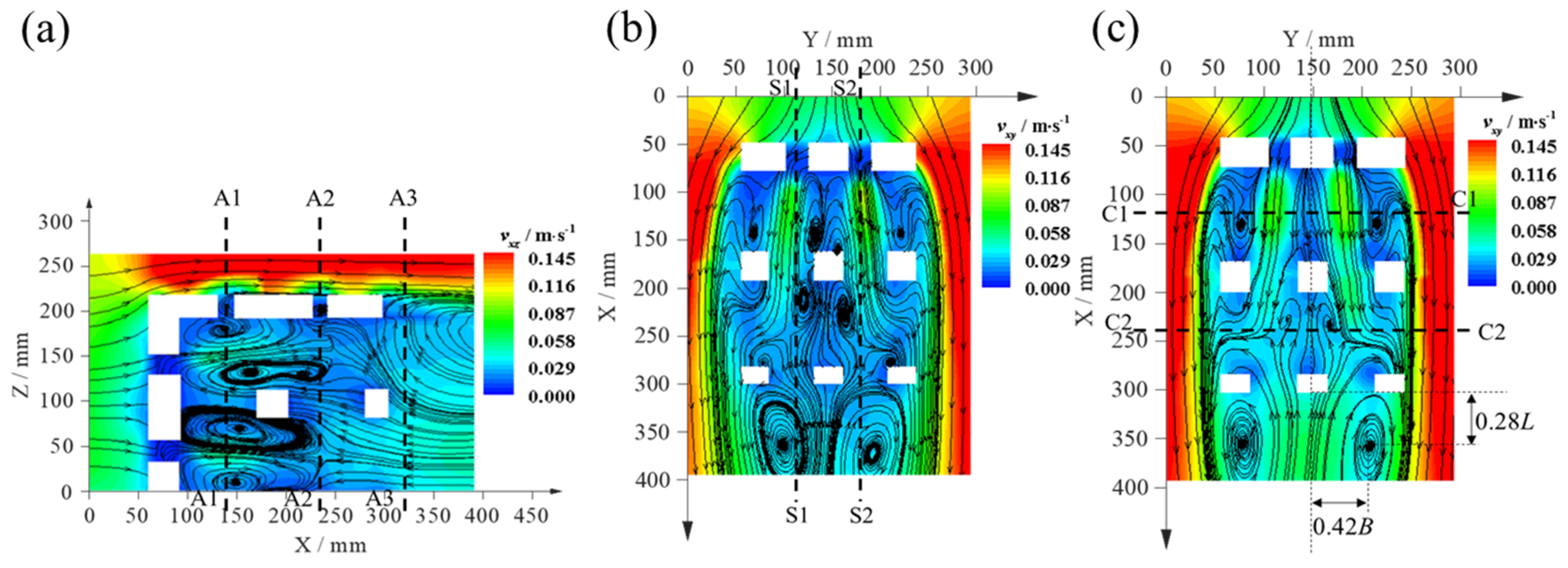
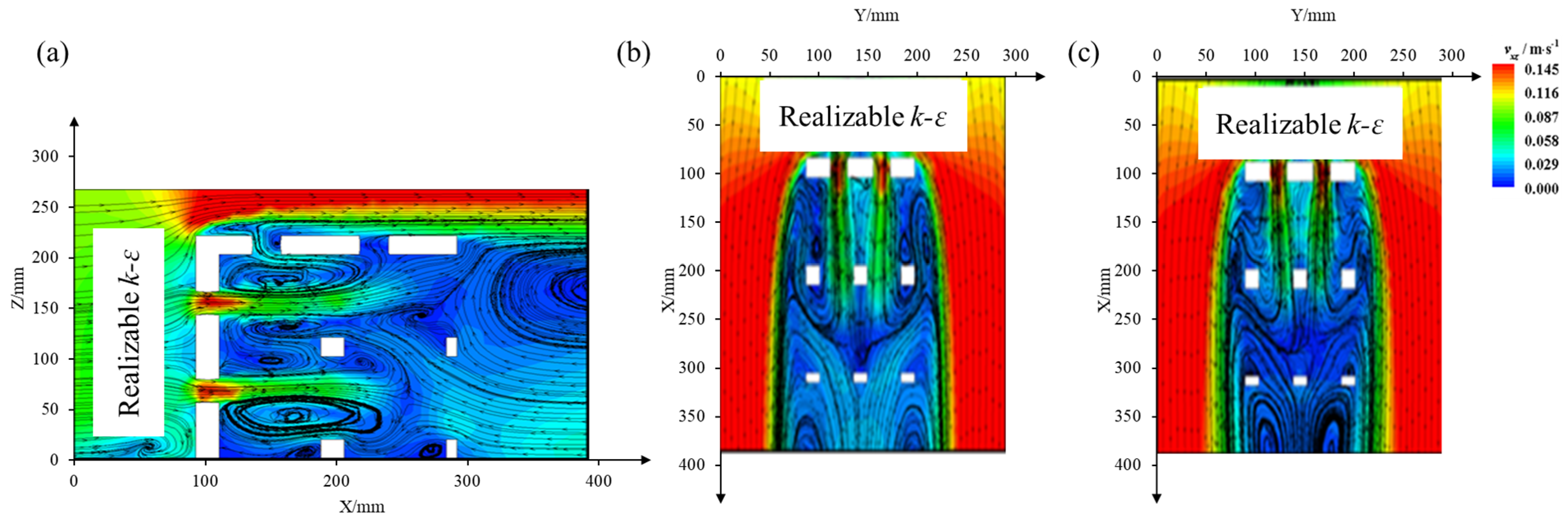
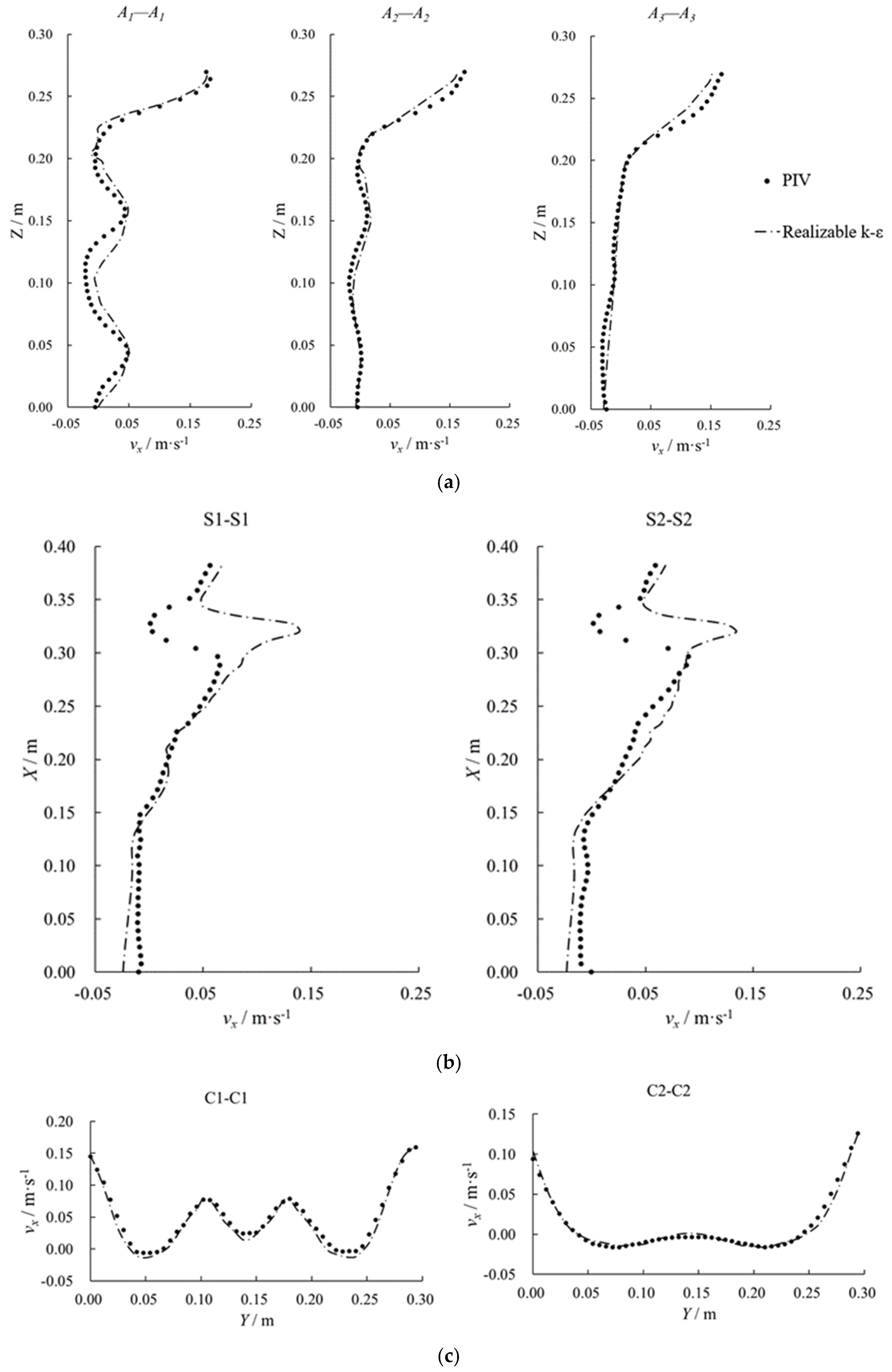

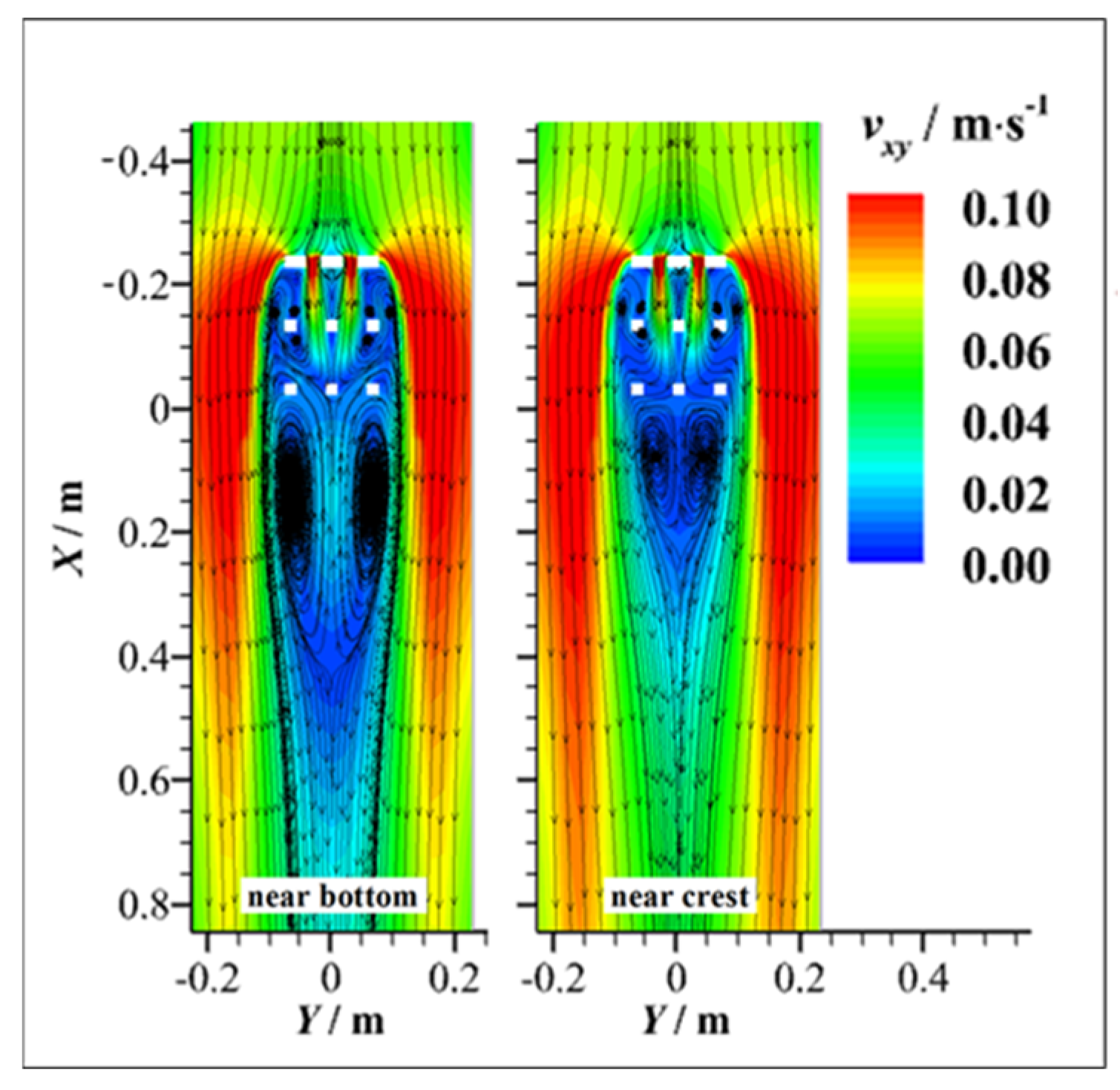
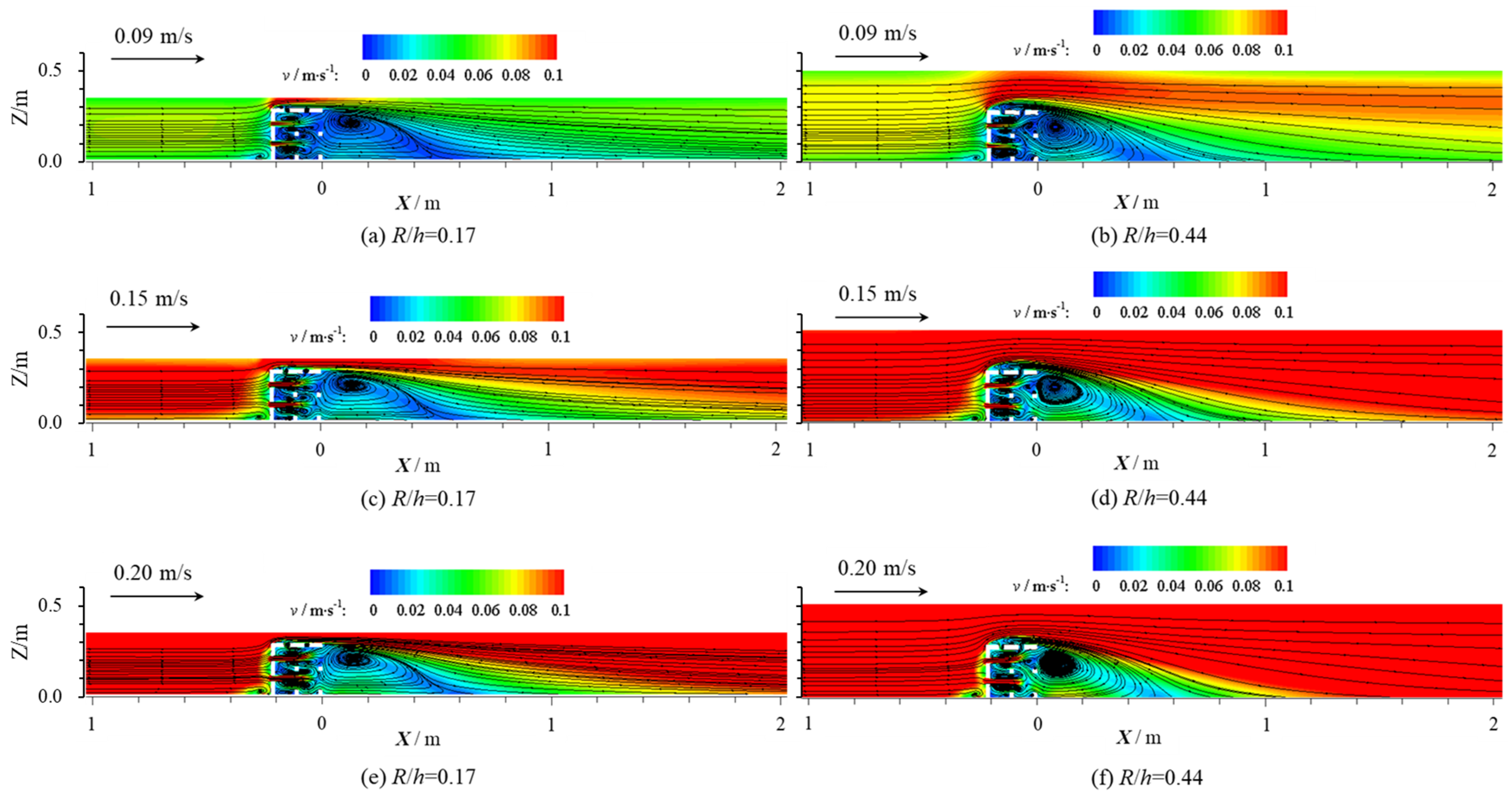
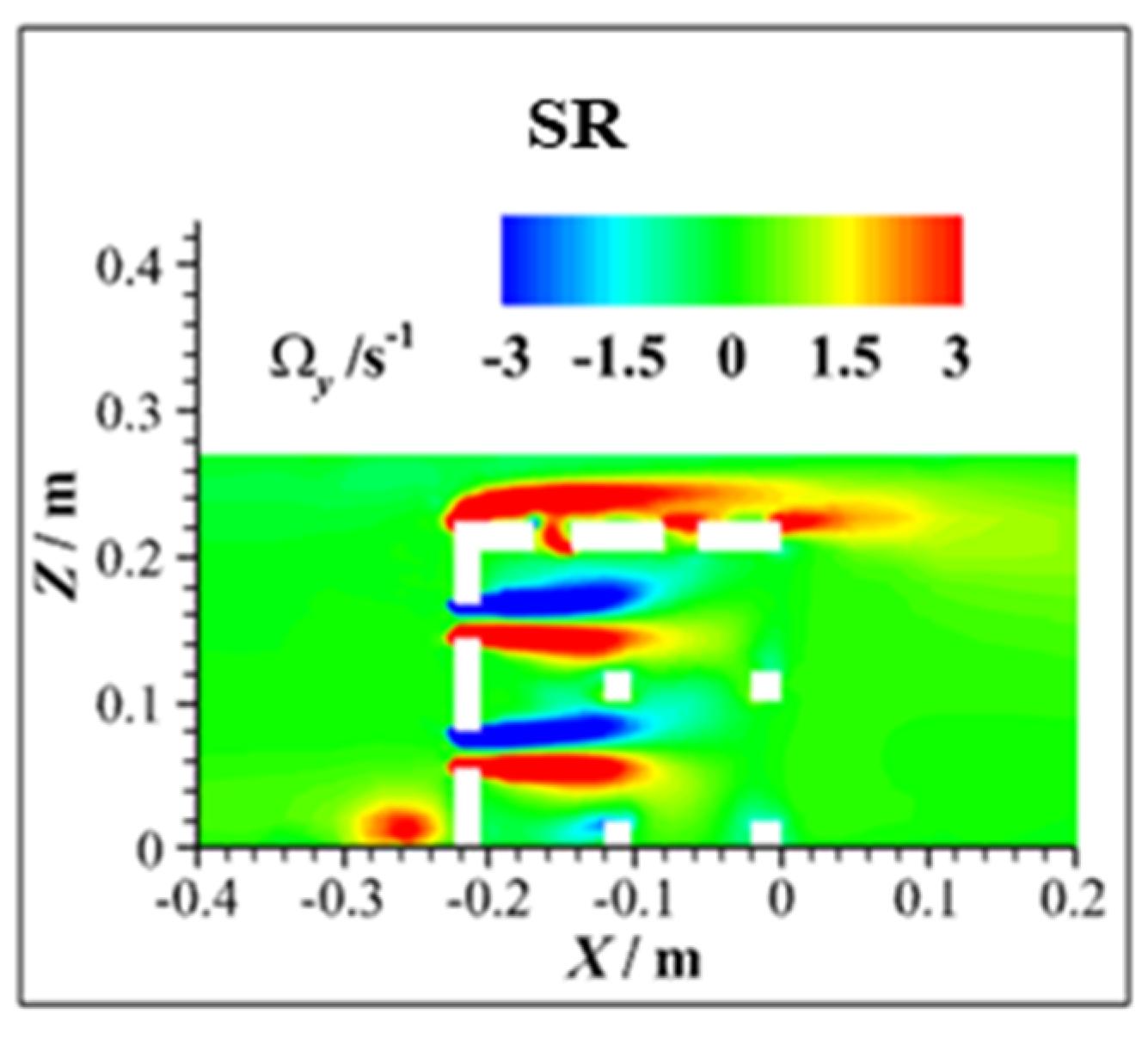

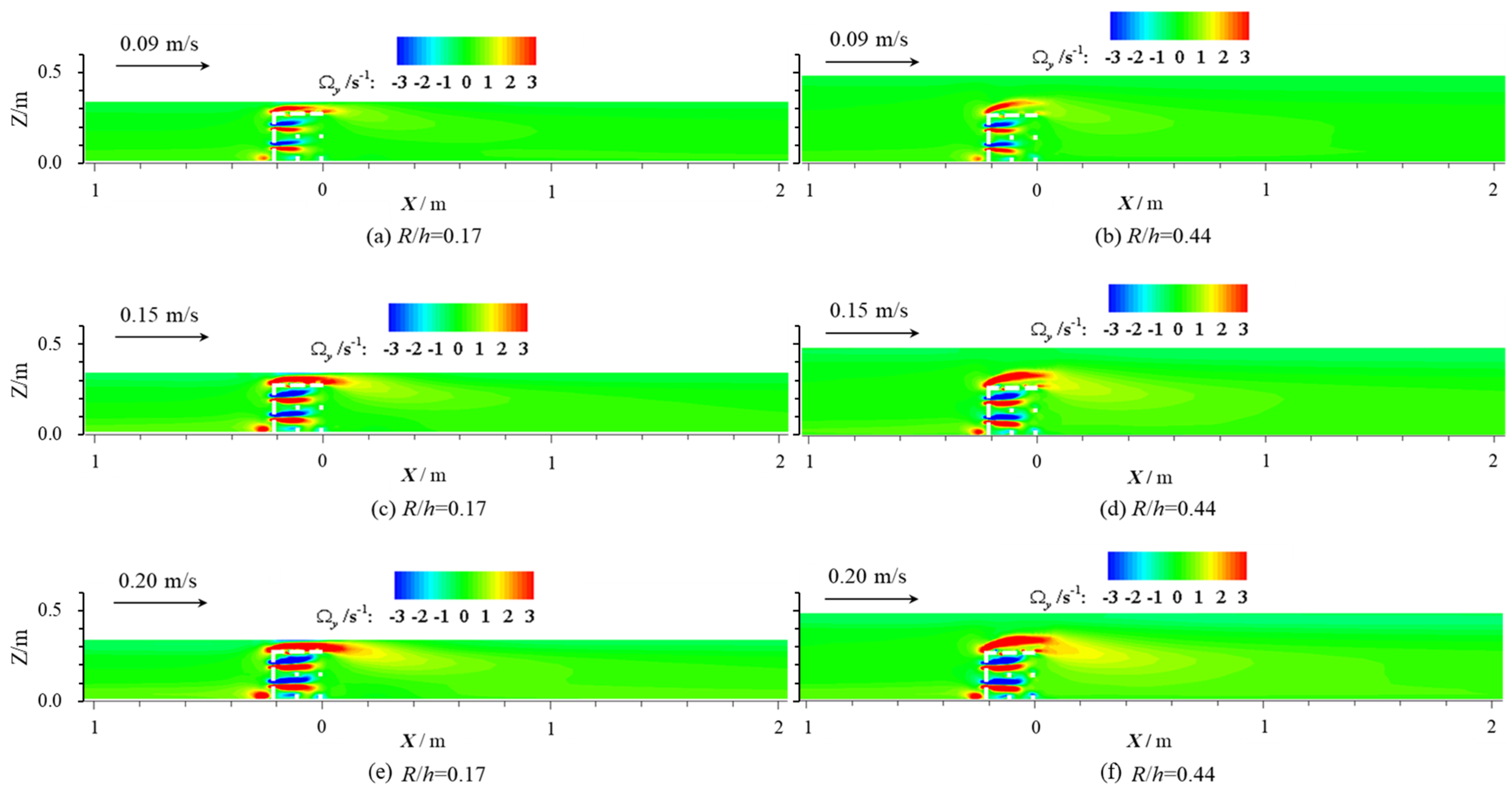
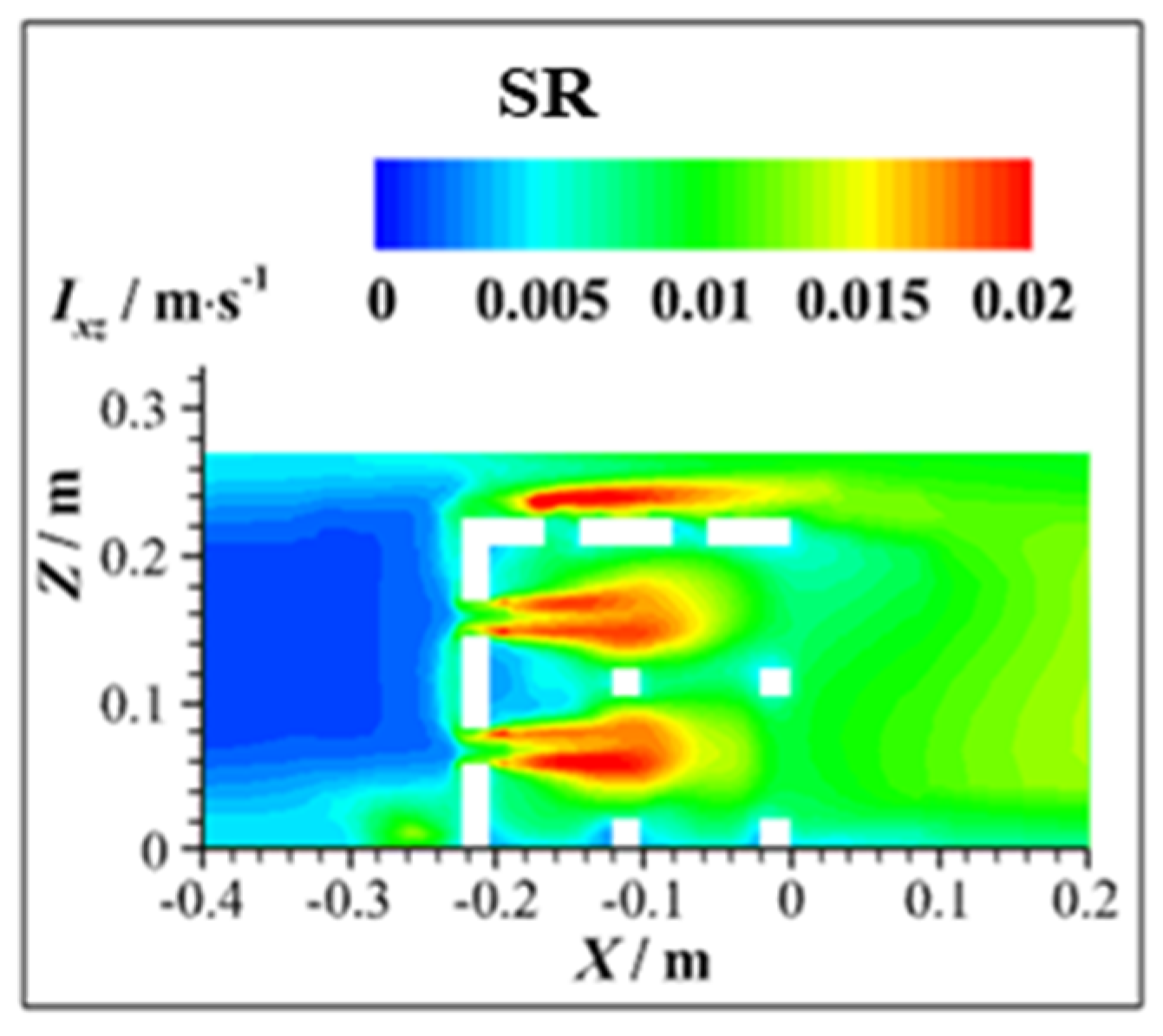

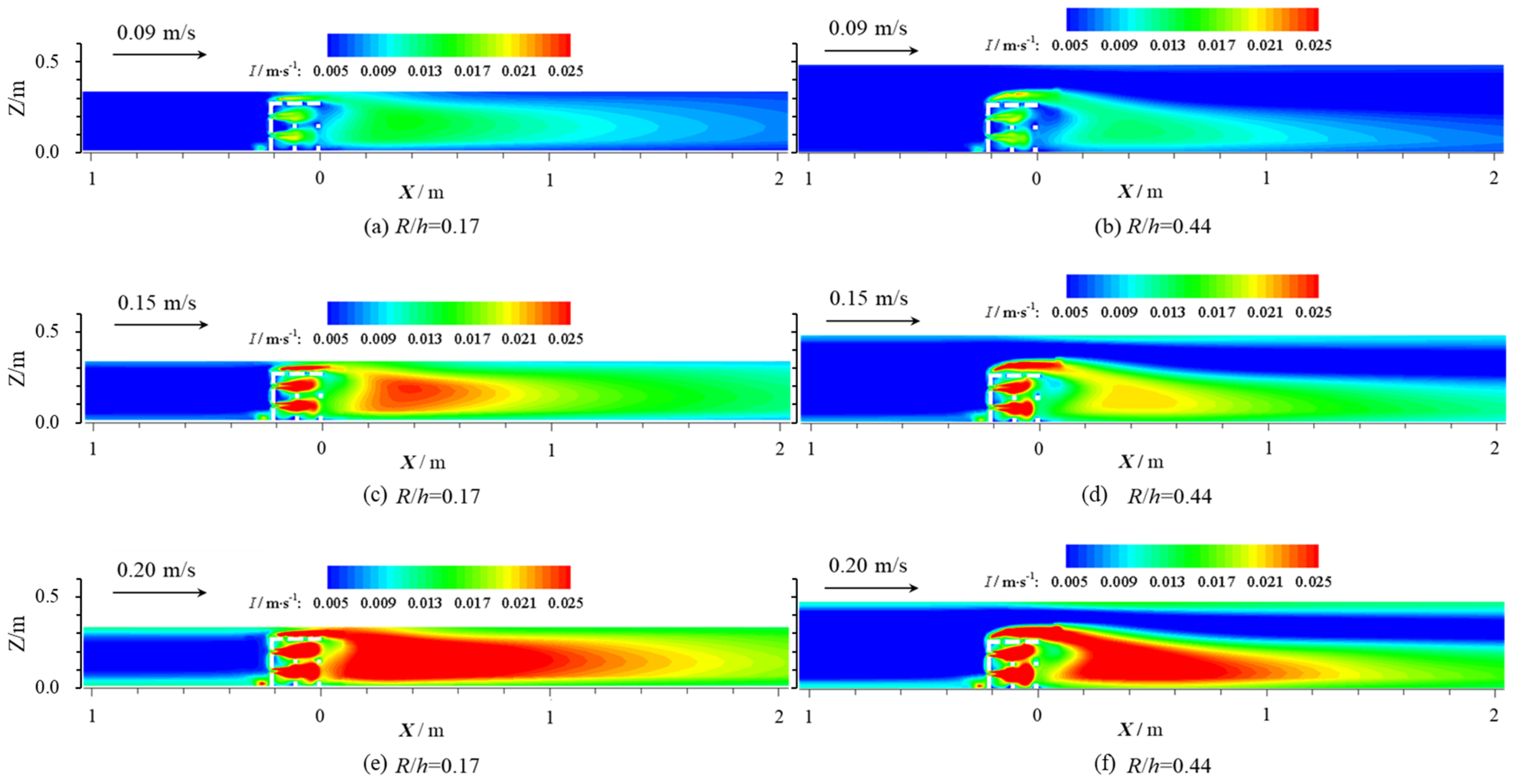
| R/h | Inflow Velocity (m/s) |
|---|---|
| 0.17 | 0.09 |
| 0.15 | |
| 0.20 | |
| 0.44 | 0.09 |
| 0.15 | |
| 0.20 |
| Inflow Velocity (m/s) | R/h = 0.17 | R/h = 0.44 |
|---|---|---|
| 0.09 | 2.11 | 2.24 |
| 0.15 | 2.24 | 2.39 |
| 0.20 | 2.31 | 2.51 |
| Inflow Velocity (m/s) | R/h = 0.17 | R/h = 0.44 | ||||||
|---|---|---|---|---|---|---|---|---|
| Area (×10−3 m2) | Mean Vorticity (s−1) | Area (×10−3 m2) | Mean Vorticity (s−1) | |||||
| Ωy > 1.5 s−1 | Ωy < −1.5 s−1 | Ωy > 1.5 s−1 | Ωy < −1.5 s−1 | Ωy > 1.5 s−1 | Ωy < −1.5 s−1 | Ωy > 1.5 s−1 | Ωy < −1.5 s−1 | |
| 0.09 | 4.074 | 4.085 | 3.701 | −3.801 | 3.983 | 3.973 | 3.688 | −3.771 |
| 0.15 | 7.202 | 6.704 | 4.905 | −5.083 | 6.495 | 6.246 | 5.198 | −5.205 |
| 0.20 | 9.021 | 8.266 | 5.923 | −6.169 | 7.832 | 7.368 | 6.397 | −6.411 |
Disclaimer/Publisher’s Note: The statements, opinions and data contained in all publications are solely those of the individual author(s) and contributor(s) and not of MDPI and/or the editor(s). MDPI and/or the editor(s) disclaim responsibility for any injury to people or property resulting from any ideas, methods, instructions or products referred to in the content. |
© 2024 by the authors. Licensee MDPI, Basel, Switzerland. This article is an open access article distributed under the terms and conditions of the Creative Commons Attribution (CC BY) license (https://creativecommons.org/licenses/by/4.0/).
Share and Cite
Kuang, C.; Li, H.; Zheng, Y.; Xing, W.; Cong, X.; Chen, J. Turbulent Characteristics of a Submerged Reef under Various Current and Submergence Conditions. J. Mar. Sci. Eng. 2024, 12, 214. https://doi.org/10.3390/jmse12020214
Kuang C, Li H, Zheng Y, Xing W, Cong X, Chen J. Turbulent Characteristics of a Submerged Reef under Various Current and Submergence Conditions. Journal of Marine Science and Engineering. 2024; 12(2):214. https://doi.org/10.3390/jmse12020214
Chicago/Turabian StyleKuang, Cuiping, Hongyi Li, Yuhua Zheng, Wei Xing, Xin Cong, and Jilong Chen. 2024. "Turbulent Characteristics of a Submerged Reef under Various Current and Submergence Conditions" Journal of Marine Science and Engineering 12, no. 2: 214. https://doi.org/10.3390/jmse12020214







